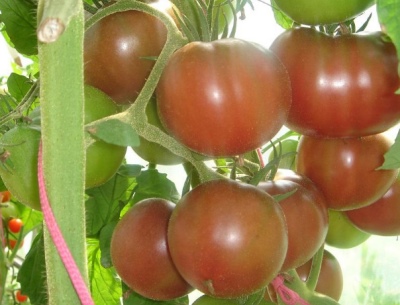
- Authors: Nalizhytiy V. M., Korotkov S. A., Dynnik A. V., Kochkin A. V., JSC 'Scientific and Production Corporation' NK. LTD '
- Year of approval: 2000
- Category: grade
- Growth type: semi-determinant
- Appointment: fresh consumption
- Ripening period: mid-season
- Ripening time, days: 110-115
- Growing conditions: for open ground, for film greenhouses
- Transportability: Yes
- Bush height, cm: 100-120
The Gypsy tomato is a rather interesting and popular variety among gardeners, which is appreciated for its unusual appearance and excellent taste. The variety began to be actively cultivated in personal subsidiary plots not so long ago - since 2000, after the employees of ZAO Scientific and Production Corporation NK. LTD ”, which were engaged in breeding work on it, confirmed all the varietal characteristics of the Gypsy.
Description of the variety
The Gypsy tomato is a tall variety with a determinate growing type. The height of the bushes varies from 85 to 130 cm. They are quite compact, grow upward and need to be tied and dived. The leaves of the variety have the usual "tomato" shape. Fruits are formed on clusters that grow after every third pair of leaves. On one hand, from 3 to 6 fruits can form.
The main qualities of the fruit
The very name of the variety suggests that this tomato is black-fruited. The fruits range in color from purple-brown and dark red to chocolate, with a characteristic greenish cut at the stem. The shape of the fruits is round, correct, the weight varies from 80 to 250 g. Their size depends on the correct care and the region of cultivation - the more comfortable these conditions, the larger the size of the fruits, and, accordingly, the more abundant fruiting.
Taste characteristics
Gypsy is a salad variety of tomatoes. The taste of the fruit is very rich, sweet at full ripeness of the fruit. The amount of sugar in them reaches 2.5%, which is a pretty good indicator. The pulp is rich, fleshy, dense. The skin is thin, elastic, due to its smoothness and density, it allows the fruit to be stored for a long time.
Ripening and fruiting
The Gypsy tomato belongs to the mid-season varieties. The fruits reach technical ripeness 110-115 days after germination under the right conditions of care and optimal heat conditions.
Yield
Gypsy bears fruit within 2 months, and during this time up to 7 kg of fruit can be removed from 1 m2
The timing of planting seedlings and planting in the ground
Seeds are sown for seedlings in March-April. On the 10th day after germination, boxes with seedlings are moved from a dark place to a lighted area (usually a window sill). If necessary, it is necessary to additionally illuminate the seedlings with a phytolamp to stimulate their growth. When the height of the bush reaches about 30-40 cm and the optimal temperature regime is established outside (usually in May), the seedlings are placed in a greenhouse. After a week in the new climate, the seedlings can be transplanted into the ground.

Growing tomato seedlings is an extremely important process, because it largely depends on whether the gardener will be able to harvest at all. All aspects must be taken into account, from seedbed preparation to planting in the ground.
Landing scheme
The seedlings are placed in holes arranged according to the scheme 60 by 40 or 50 by 50 cm. Such a distance in the future will allow you to easily approach each bush in order to care for it and in the future will allow you to harvest without hindrance.

Growing and care
Tomato Gypsy loves organic-rich light soil. To ensure such conditions, you need to take care of the saturation of the soil with useful substances in the fall. To do this, humus, organic fertilizer and a potassium-nitrogen mixture must be added to the holes. If the soil is too dense, it is advisable to add peat to lighten it a little.
After the end of flowering and after the formation of fruits, the bushes must be formed by removing the upper shoots. This will give the plant more strength to ripen the crop rather than growing foliage.
When the height of the tomatoes reaches the maximum height, and the bushes begin to stick to the ground, they must be tied to specially prepared pegs. This will give the fruit more sunshine and a richer flavor.
During the growth period, the Gypsy tomato needs nitrogen fertilizers. Once a week, you need to water the bushes with a urea solution (2 tablespoons per 10 liters of water).




A plant needs different micronutrients at each stage of growth. All fertilizers can be divided into two groups: mineral and organic. Folk remedies are often used: iodine, yeast, bird droppings, eggshells.
It is important to observe the rate and period of feeding. This also applies to folk remedies and organic fertilizers.


Growing regions
The Gypsy tomato has proven itself to be excellent in almost all regions of Russia, with the exception of the Far North. The only thing to consider is that growing in the open field north of the Volga region will not be as successful as in a greenhouse. In the south, the Gypsy will feel great without additional shelter.

























































































